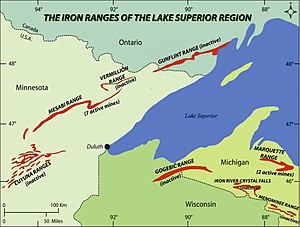
The Iron Range is collectively or individually a number of elongated iron-ore mining districts around Lake Superior in the United States and Canada. Much of the ore-bearing region lies alongside the range of granite hills formed by the Giants Range batholith.[1] These cherty iron ore deposits are Precambrian in the Vermilion Range and middle Precambrian in the Mesabi and Cuyuna ranges, all in Minnesota. The Gogebic Range in Wisconsin and the Marquette Iron Range and Menominee Range in Michigan have similar characteristics and are of similar age. Natural ores and concentrates were produced from 1848 until the mid-1950s, when taconites and jaspers were concentrated and pelletized, and started to become the major source of iron production.[2]
The mining districts are in Minnesota's Arrowhead Region. The region's far eastern area, containing the Duluth Complex along the shore of Lake Superior, and the far northern area, along the Canada–U.S. border, are not associated with iron ore mining, but deposits of copper, nickel, and cobalt at the northern boundary of the Duluth Complex, where it meets the iron formations, are being considered for mining.[3]
- ^ Allison, Ira S. (July 1925). "The Giants Range Batholith of Minnesota". The Journal of Geology. 33 (5): 488–508. doi:10.1086/623215. hdl:2027/uc1.$b30134. S2CID 140669590.
- ^ Marsden, Ralph (1968). John D. Ridge (ed.). Geology of the Iron Ores of the Lake Superior Region in the United States, in Volume 1 of Ore Deposits of the United States, 1933–1967. The American Institute of Mining, Metallurgical, and Petroleum Engineers, Inc. pp. 490–492.
- ^ "Nonferrous Metallic Minerals - Exploration Areas". Minnesota Department of Natural Resources. Retrieved December 14, 2022.
